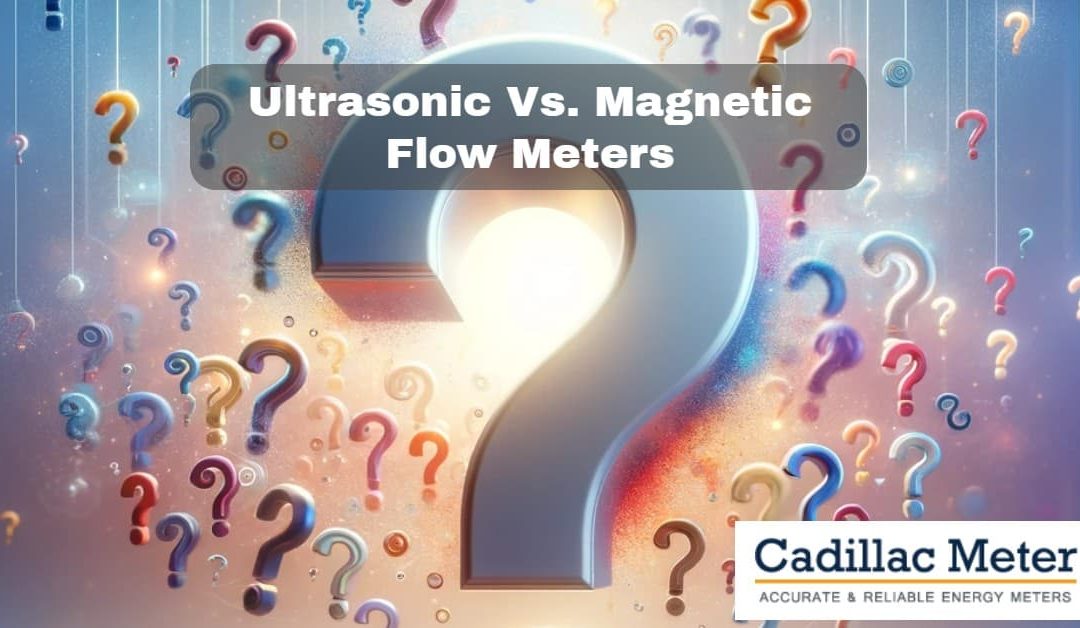While selecting the proper flow meter technology for your system is critical, your ability to rely on the meter’s readings will depend more heavily on the application. Every meter technology will have its advantages and disadvantages, but it’s the nuances of your system and what is flowing through it that should garner the most attention.
Let’s talk about water applications, for example. For a simple application like water, there are a dozen different technologies that can work well. But, does the water contain bubbles or particles? Is it ionized? Answering these questions will make a big difference in the types of flow meters that would be ideal for your system. For water in many forms, magnetic and ultrasonic flow meters have become popular technologies. Let’s review their pros and cons…
Ultrasonic Flow Meters
Ultrasonic flow meters will detect and measure flow rates without invading the flow stream or using moving parts. To do so, they employ one of two following principles of operation.
Transit-Time Ultrasonic Flow Meters send a sound wave through the flow, relying on the difference in time between upstream and downstream times of flight. This difference in time is proportional to the velocity of the flow. Transit-time flow meters are not suited for water with heavy aeration or high concentrations of solids or suspended particles as this can obstruct the sound waves. They are more appropriately used for clean and ultra-pure flows.
Doppler Ultrasonic Flow Meters also send a sound wave into the flow, but contrary to transit-time technology, Doppler meters depend on suspended bubbles and particles in the water to reflect the sound waves providing a shift in the frequency. Any shift in the frequency of reflections is proportional to the flow velocity. Therefore, Doppler ultrasonic flow meters are obviously better suited for aerated or impure water applications (i.e. waste-water).
Pros:
-
By far, the best reason to use an ultrasonic flow meter of any kind is the lower costs associated with installation. Your system would not need to be shut down and your piping would not need to be altered.
-
Device will not obstruct flow or contaminate processes
-
Lack of moving parts means less maintenance
-
Flow range typically 100:1
-
Can be used with corrosive fluids
-
Zero pressure drop (Magnetic flow meters also provide no pressure drop if you are installing a meter the same size as the line size)
-
Operates on pipe diameters from 1/2” to 200” (may require 2 or 3 different sets of transducer depending on pipe size and range transducers cover)
-
Insensitive to changes in temperature, viscosity, density or pressure (Temperature will effect the transit time sensor selection requiring high temp sensors above 250F.)
-
Available in a wide variety of communication protocols (Transit Time)
-
Ability to register locally, remotely or to interface with an energy management system (Transit Time)
Cons:
-
Similar to many of the devices we examined in Not All Flow Meters Are Created Equal! Part 2, the accuracy of ultrasonic flow meters becomes much less dependable when the flow rate drops below 2 ft/s.
-
Any number of unknown internal piping variables can shift the flow signal and create inaccuracies
-
The scaling, pitting, and fouling that can occur over time in older piping systems can be problematic.
-
Accuracy may be affected by air space in the pipe
-
Accuracy may be affected by the size distribution of particles and any relative velocity between particles and the water (Doppler)
Magnetic Flow Meters
Magnetic flow meters (a.k.a magmeters) measure flow rates by employing Faraday’s Law of Electromagnetic Induction. A magnetic field is created by running current through a coil sounding the flow tube. The conductive media/liquid then creates a voltage as it passes through the flow tube and magnetic field of the meter. The electrodes sense and measure the voltage created as the liquid passes through the tube. The greater the velocity the higher the voltage, thus creating the proportional signal that is eventually converted to volumetric flow. Magnetic flow meters are specifically designed for systems that move conductive fluids like water, acids, caustic liquids, and slurries.
Pros:
-
No moving parts or flow obstructions
-
Almost zero pressure drop (Since the coefficient of friction for the liner materials (Teflon) may be lower than the actual piping material they may provide less of a pressure drop than the same length of piping material)
-
Accurate to +/-0.25% of reading
-
Flow range turn-down of 300 to 1 or better
-
Available for pipe diameters from 1/10” to 120”
-
Relatively unaffected by viscosity, temperature and pressure as long as the magmeter is selected based on the process conditions
-
Applicable to all flow profiles and does not require straight run (only the CMAG can make this statement.)
-
Can respond well to rapid changes in flow
-
Applicable to liquids with heavy particulates
-
Available in a wide variety of communication protocols
-
Ability to register locally, remotely or to interface with an energy management system
-
Service life of 75 years
Cons:
-
Water must contain a certain amount of Microsiemens (uS), giving it the power to conduct heat and/or electricity. Some magmeters can work down to 2-3 uS/cm, while other require 10 uS/cm or more.
-
Accuracy may be affected by air space in the pipe
If you’d like to discuss flow meter options for your processes, give us a call at (888) 556-3913 or email us at sales@cadillacmeter.com.



